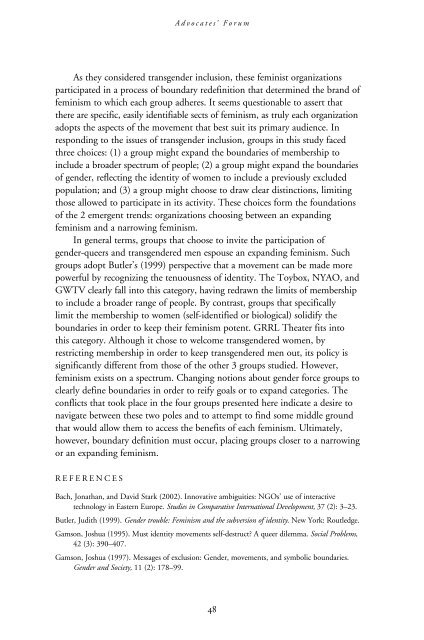2006 - School of Social Service Administration - University of Chicago
2006 - School of Social Service Administration - University of Chicago
2006 - School of Social Service Administration - University of Chicago
Create successful ePaper yourself
Turn your PDF publications into a flip-book with our unique Google optimized e-Paper software.
Advocates’ Forum<br />
As they considered transgender inclusion, these feminist organizations<br />
participated in a process <strong>of</strong> boundary redefinition that determined the brand <strong>of</strong><br />
feminism to which each group adheres. It seems questionable to assert that<br />
there are specific, easily identifiable sects <strong>of</strong> feminism, as truly each organization<br />
adopts the aspects <strong>of</strong> the movement that best suit its primary audience. In<br />
responding to the issues <strong>of</strong> transgender inclusion, groups in this study faced<br />
three choices: (1) a group might expand the boundaries <strong>of</strong> membership to<br />
include a broader spectrum <strong>of</strong> people; (2) a group might expand the boundaries<br />
<strong>of</strong> gender, reflecting the identity <strong>of</strong> women to include a previously excluded<br />
population; and (3) a group might choose to draw clear distinctions, limiting<br />
those allowed to participate in its activity. These choices form the foundations<br />
<strong>of</strong> the 2 emergent trends: organizations choosing between an expanding<br />
feminism and a narrowing feminism.<br />
In general terms, groups that choose to invite the participation <strong>of</strong><br />
gender-queers and transgendered men espouse an expanding feminism. Such<br />
groups adopt Butler’s (1999) perspective that a movement can be made more<br />
powerful by recognizing the tenuousness <strong>of</strong> identity. The Toybox, NYAO, and<br />
GWTV clearly fall into this category, having redrawn the limits <strong>of</strong> membership<br />
to include a broader range <strong>of</strong> people. By contrast, groups that specifically<br />
limit the membership to women (self-identified or biological) solidify the<br />
boundaries in order to keep their feminism potent. GRRL Theater fits into<br />
this category. Although it chose to welcome transgendered women, by<br />
restricting membership in order to keep transgendered men out, its policy is<br />
significantly different from those <strong>of</strong> the other 3 groups studied. However,<br />
feminism exists on a spectrum. Changing notions about gender force groups to<br />
clearly define boundaries in order to reify goals or to expand categories. The<br />
conflicts that took place in the four groups presented here indicate a desire to<br />
navigate between these two poles and to attempt to find some middle ground<br />
that would allow them to access the benefits <strong>of</strong> each feminism. Ultimately,<br />
however, boundary definition must occur, placing groups closer to a narrowing<br />
or an expanding feminism.<br />
REFERENCES<br />
Bach, Jonathan, and David Stark (2002). Innovative ambiguities: NGOs’ use <strong>of</strong> interactive<br />
technology in Eastern Europe. Studies in Comparative International Development, 37 (2): 3–23.<br />
Butler, Judith (1999). Gender trouble: Feminism and the subversion <strong>of</strong> identity. New York: Routledge.<br />
Gamson, Joshua (1995). Must identity movements self-destruct? A queer dilemma. <strong>Social</strong> Problems,<br />
42 (3): 390–407.<br />
Gamson, Joshua (1997). Messages <strong>of</strong> exclusion: Gender, movements, and symbolic boundaries.<br />
Gender and Society, 11 (2): 178–99.<br />
48
















